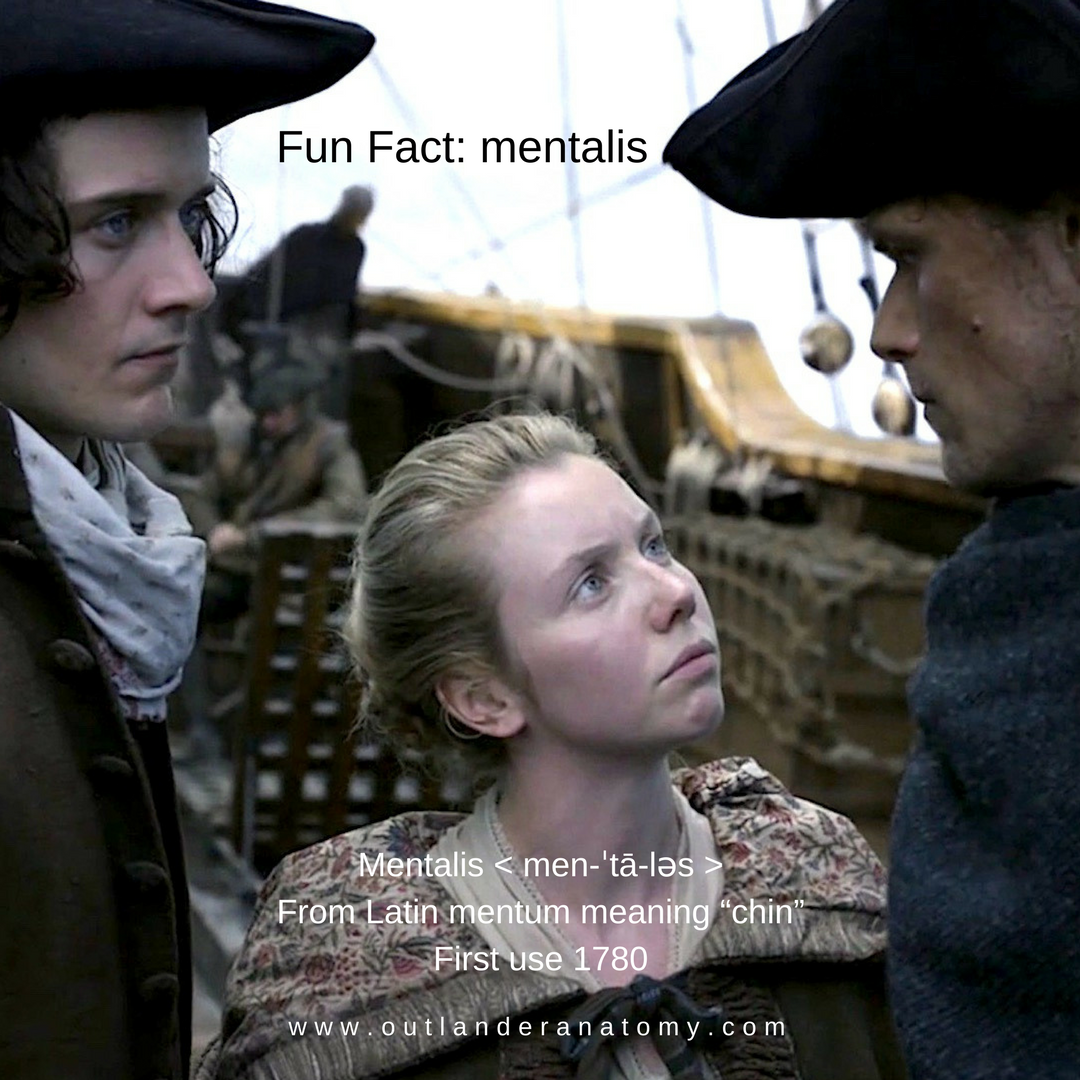A hearty hello to valued anatomy students! Today’s Anatomy Lesson #26 is the Chin. A few months back several students asked for a lesson on Jamie’s chin so here it is. Serendipitously, this past week I also followed an avid Facebook discussion focused entirely on Jamie’s chin. Being a demure lady (snort!) I canna repeat the ideas that were posted; suffice it to say they were imaginative! Mmmphm. And, as Herself mentions the chin often in her Outlander books, let’s go!
English idioms about body parts are always fun to consider. Interestingly there are not many about the chin and most are concerned with either stamina or aggression: keep your chin up, take it on the chin, lead with the chin, catch it on the chin, wag one’s chin and to quote a particular portly pig (and some rappers) “not by the hair of my chinny chin chin!”
Right off the bat, let’s get the most important chin issue resolved and out of the way: Jamie’s chin is the strongest, handsomest and most manly mentus in filmdom (Starz episode 102, Castle Leoch)! Gah! Not sure I can keep me train of thought, but I’ll try!
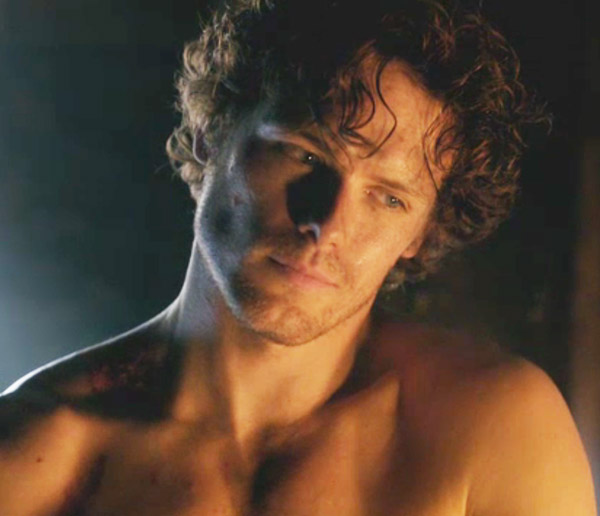
So verra delighted and deeply (ha ha) grateful that this man was chosen to play the King of Men! Even English nobility shares this opinion. Consider the Duke of Sandringham swiping his fingers across Jamie’s most excellent chin (Starz episode 110, By the Pricking of My Thumbs):
“Alas, my servants are chosen for their beauty, not their belligerence.”
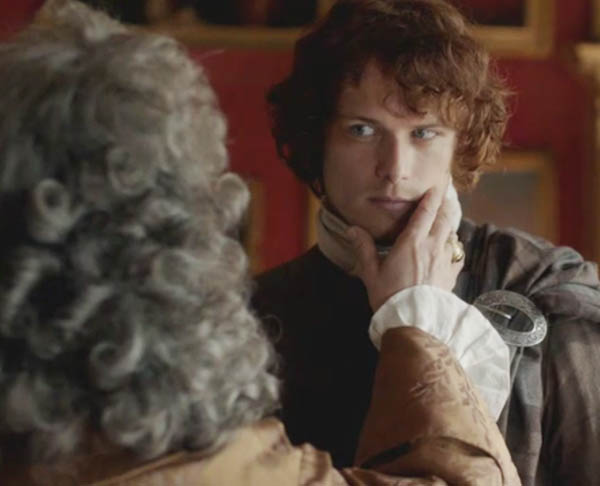
“You, of course, contain within you a sublime combination of the two!”
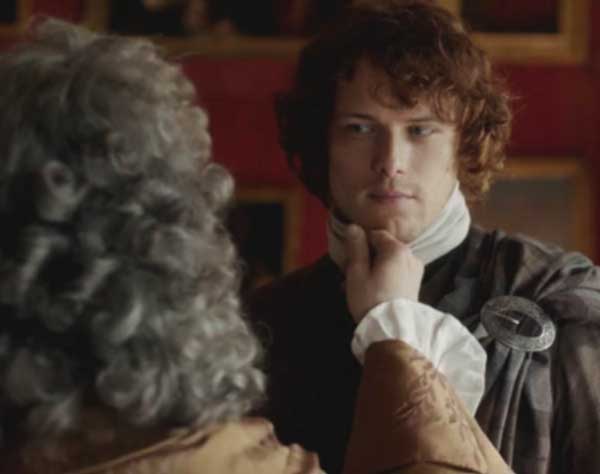
This smarmy old rascal is spot on: Jamie, you are indeed a sublime blend of beauty and belligerence! Best you look askance at the Duke and his roving fingers; Claire willna like him fondling yer chinny chin chin! Sandringham invokes the lyrics from “You Did It” (My Fair Lady): “Oozing charm from every pore. He oiled his way around the floor.” Grrrreasy!
Now for chin anatomy: More than 200 years ago, the German physician, naturalist, physiologist and anthropologist, Johann Friedrich Blumenbach (1752 – 1840) declared that the chin is a uniquely human feature. Nowadays, most naturalists agree that elephants (Photo A) and perhaps two other mammals have chins but few species other than humans can lay claim to this body part.
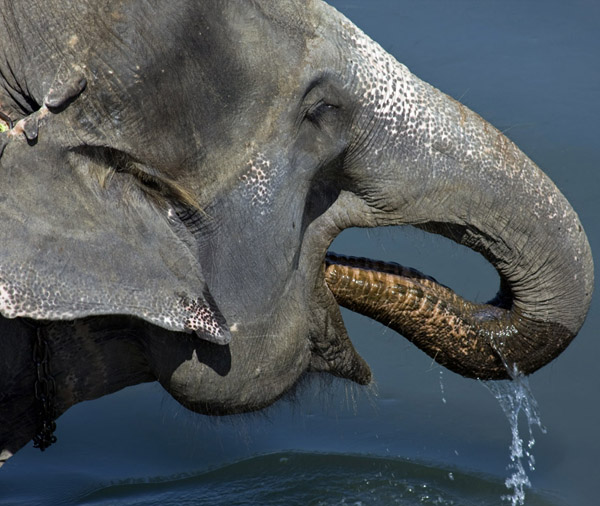
Photo A
A few scholarly circles hotly debate, why do we have a chin and what is its purpose? One cool idea posits that the human chin emerged due to speech and mastication (chewing) patterns. Indeed, computer models show that mechanical stress relating to muscle pull could contribute to chin development.
Another proposed reason for the human chin is sexual dimorphism, the different appearance of a body part between the genders. Typically, female chins are smaller and rounder and male chins are bigger and squarer. Such differences, it is argued, contribute to attractiveness and augment mate selection. And, don’t our Claire and Jamie demonstrate chin sexual dimorphism to a T (Starz episode 101, Sassenach)?
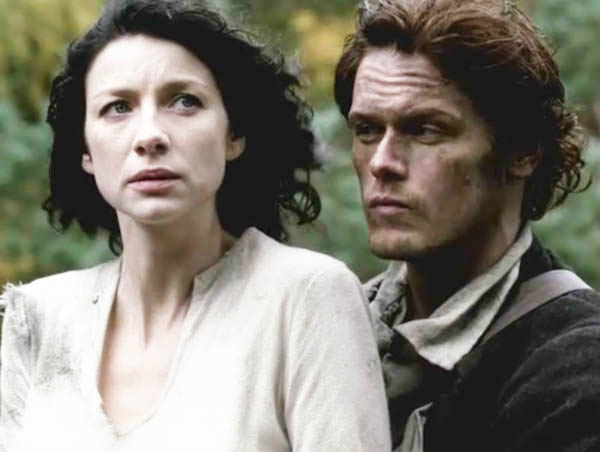
Alas, the June 2015 Smithsonian reports that the chin didn’t develop to make us swoon nor to accommodate speech or distribute the stress of chewing. Rather, newest thinking declares the chin is the by-product of a shrinking face: over the eons, the face has decreased in size and tilted inward which in effect pushes chin and jaw outward. As for me, I prefer the sexual rif, thank you very much!
More chin anatomy: the mentus (Latin meaning chin) has several topographical features. First, the chin (Photo B –black arrow) and nose are typically the most forward projecting parts of the face. The chin has a bony base but the fleshy, moveable tip is the chin pad. From the point of the chin a pair of bony horizontal ridges project backward (Photo B – green arrow) each ending as a bony angle (Photo B – purple arrow). Between the lower lip and the chin is a horizontal skin groove, the mentolabial sulcus (Photo B – blue arrow).
Try this: What, there’s work to do already? Yep! Grip and wiggle your chin pad. Next, find your mentolabial sulcus, left and right horizontal bony ridges and bony angles. Very nice and good for you!
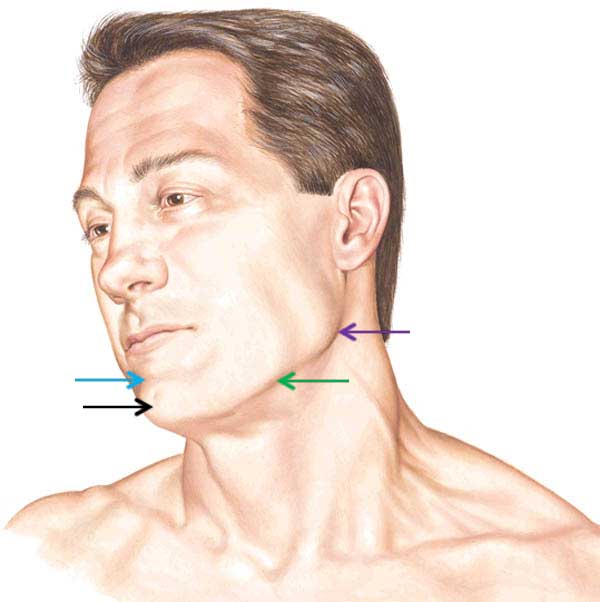
Photo B
The projecting point of the mandible (Latin meaning jawbone) provides the bony foundation for the chin. The mandible arises during fetal life where it develops as right and left halves joined in the midline by a thin plate of fibrocartilage (Anatomy Lesson #24). The paired mandibular halves persist until the second year of life when the joint ossifies into a vertical bony ridge, the mandibular symphysis (Photo C – drawing of newborn skull).
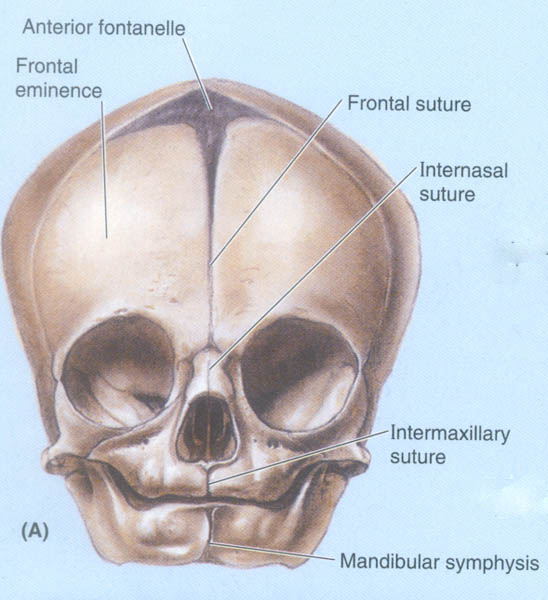
Photo C
During childhood, the chin persues the adult form as a midline triangular-shaped mental protuberance flanked on each side by a mental tubercle (Photo D). In the midline above the protuberance lies the unpaired bony ridge, the mandibular symphysis or symphysis menti (Photo D – black arrow).
Try this: Once again locate your mentolabial sulcus. Move one fingertip just below the sulcus and wiggle it back and forth. Do you feel a faint ridge? This is your symphysis menti. Move the finger downward to the bony tip. This is your mental protuberance. Now move your fingers to the left and right; do you feel a pair of small bony bumps? These are the mental tubercles. Well done!
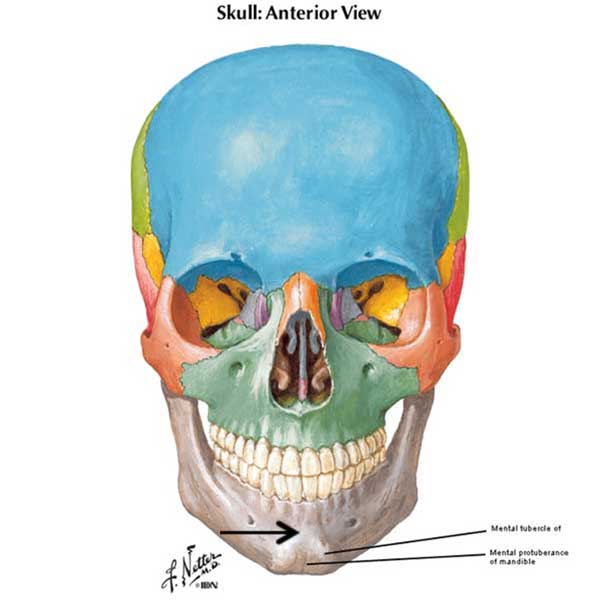
Photo D
Let’s consider more about the mandible (Anatomy Lesson #11 and Anatomy Lesson #13), the parent bone of the mentus. The mandible (unpaired after two years of age) is the strongest, largest and lowest bone of the skull and is its only moveable bone. It has a U- or V- shaped body (Photo E) expressed as the lower bony ridges mentioned above. The body ends posteriorly as the bony angles of the mandible (Photo E – only left side labelled). Jutting upward and backward from each mandibular angle is a strong bar of bone, the ramus. In the midline are bony features of the chin as described above. Lastly, the mandible has an upper alveolar part (Photo E) that serves as a receptacle for 16 adult teeth which in the best case scenario includes: four front incisors, two canines (BJR’s dog teeth – black arrows), four premolars and six molars.
Try this: Palpate the body and angles of your mandible. Look in a mirror, open your mouth and find incisors, canines, premolars and molars (if present). If your mouth is too dark to clearly see the teeth, shine a flashlight into the mirror; the light reflects back into your mouth and nicely illuminates that inner sanctum!
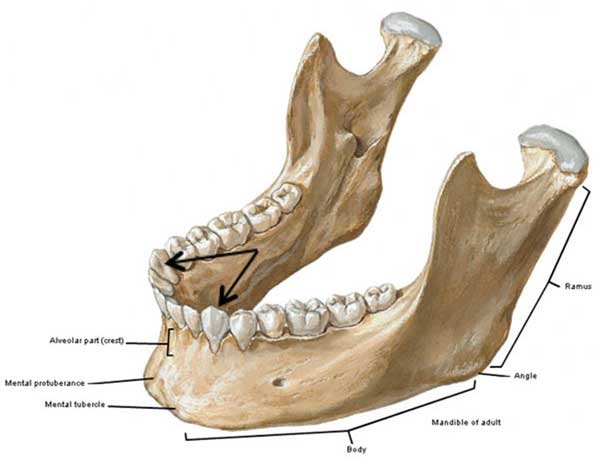
Photo E
Each mandibular ramus ends in two bony projections: a condylar process the head of which articulates with a socket in the temporal bone at the TMJ (temporomandibular joint) and the sharp coronoid process (Photo F) onto which attaches a muscle of mastication (see below). On the inner surface, each ramus has an opening, the mandibular foramen, for passage of a nerve. On the outside of the chin are left and right mental foramina (pl.) which also transmit nerves.
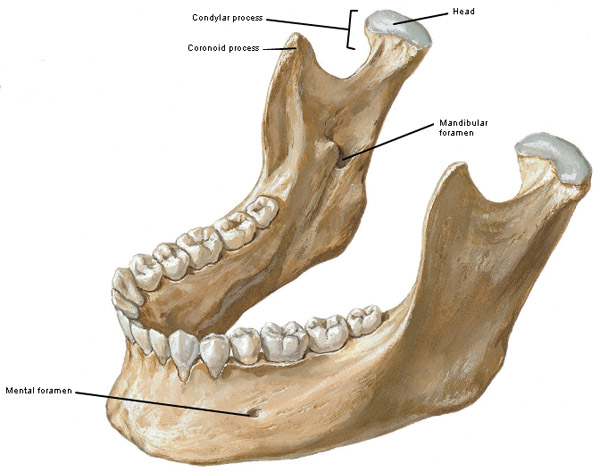
Photo F
Warning: The next image (Photo G) shows a deep dissection of the head and neck. Please skip if you find such images challenging. Three important nerves on each side of the face are pertinent to our discussion. The paired mandibular nerves (branches of Cranial Nerve V) exit the skull deep to each cheek bone (zygomatic arch – Anatomy Lesson #9). Each mandibular nerve produces left and right inferior alveolar nerves or IANs that enter the mandible via the mandibular foramina (shown in Photo F) to supply sensation to the lower teeth. Ouch! Yes, IANs are the culprits that transmit tooth pain! Along the way, each IAN gives off a mental nerve which exits via its respective mental foramen and provides sensation to lower lips, gums and chin. Bet Jenny didna ken that a nerve was named after her kindly brown-haired laddie!
Try this: Straddle your mentus with thumb and forefinger. Place them about the same vertical level as your canine teeth. Press down gently until you feel slight hollows and a tingle. These are your mental nerves exiting the mental foramina.
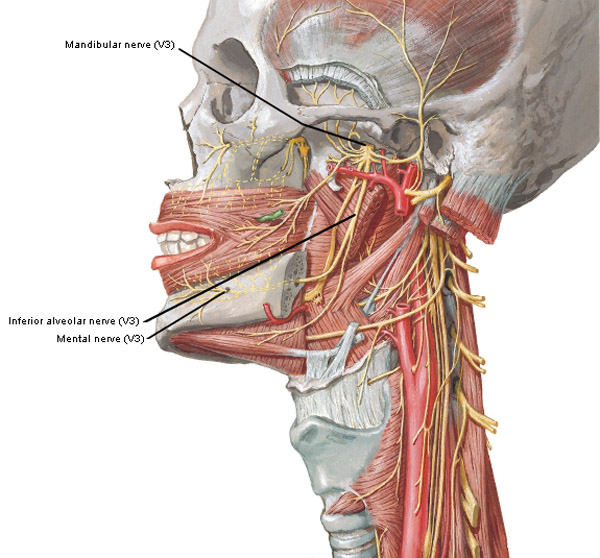
Photo G
A discussion of the chin is incomplete without considering associated muscles. A whopping 28 muscles attach to the mandible – yes, that’s 14 muscles per side! I won’t name them all. Muscles that attach to the mandible (see below) act on seven different head and neck regions. Suffice it to say that each side of the mandible has four muscles for chewing, one moves the cheek, three move the lower lip, one wrinkles neck skin, three move the tongue and two help us swallow. As if this weren’t enough, several of these muscles aid in speech by moving lips, tongue and hyoid bone (Anatomy Lesson #12). Whew! The mandible (and its chin) truly is a workhorse for head and neck muscles.
Three of the 14 muscle pairs mentioned above are easily demonstrated. Each mentalis muscle arises from the mental protuberance and inserts into the lower lip (Photo H). As they contract, the lip elevates and protrudes as in a pout; simultaneously, the skin of the chin wrinkles. They also add bulk to the chin pad. Each masseter muscle arises from the zygomatic arch (Photo H – black arrow) and inserts into body and angle of the mandible; contraction closes the jaw. The temporalis muscles are the third pair of muscles for today. These fan-shaped muscles arise from the sides of the skull and insert onto the coronoid processes (shown in Photo F) of the mandibular rami. Contraction closes and retrudes (pulls backward) the mandible.
Try this: Return to the mirror and wrinkle your chin-skin. Congrats! You just activated your mentalis muscles. Next, place your fingers in the hollow of each temple; close your teeth and retrude (pull back) the mandible. You should feel tension in each temporalis as they contract. Finally place fingertips just anterior to each mandibular angle. Bite down and feel the masseters tense as they close the mandible.
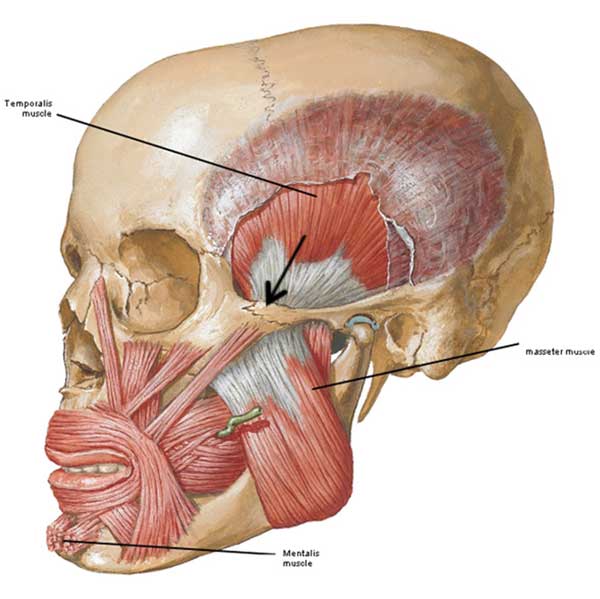
Photo H
Are these muscles at work in Outlander? Oh, to be sure! Geillis offers us a wonderful visual as she interrogates Claire before sentencing at the witch’s trial (Starz episode 111, The Devil’s Mark)! Why are you here in Scotland (English lassie has no idea) and when will you stop lying (tell the truth, the whole truth and nothing but the truth!)? Here, Geillis opens her mandible using muscles of mastication (lateral pterygoids) that we have yet to learn and are not visible from the skin surface. With the mandible widely opened, the masseter is pulled taut (green arrow) and the temporalis is stretched creating a hollow at the temple (blue arrow). Try it yourself; it works!
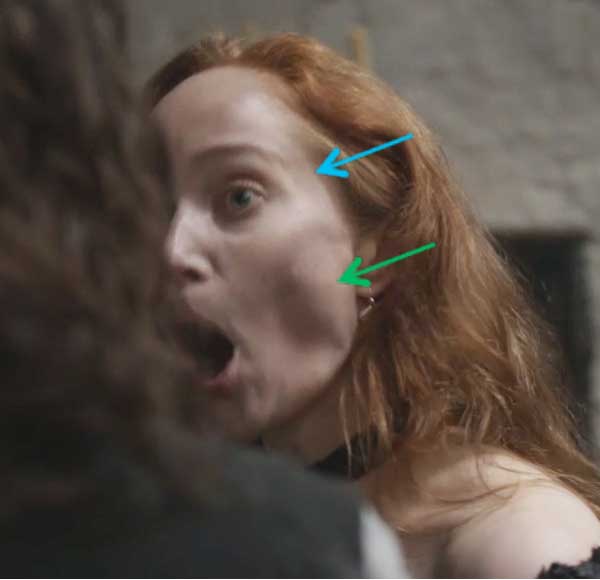
Next, Geillis closes her mandible using the powerful masseter muscles (black arrow). This wild wily witch needs some answers before she becomes kindling at her own personal bar-b-que!
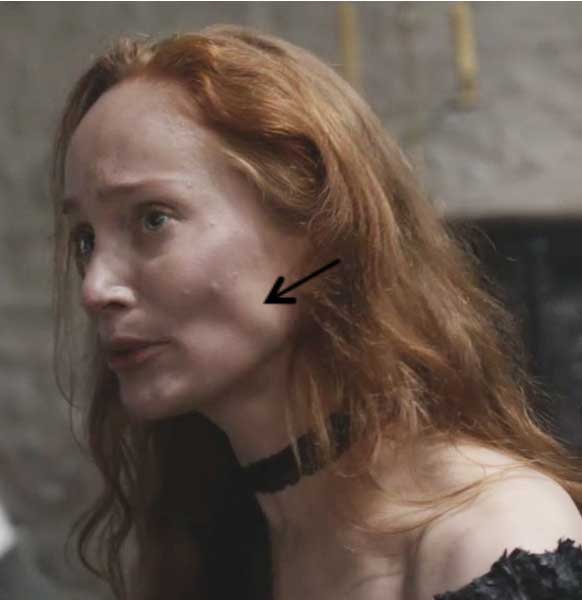
Mentalis muscles are at work “Down by the Riverside” as Sassynach and Big Red One go at it hammer and tongs! After Claire wounds an astonished Jamie with her sharp 20th century tongue, she feels verra sad (Starz episode 109, The Reckoning). This sassynach is the best chin-skin-wrinkler and lower-lip-pouter in the whole of Scotland! Yep, her mentalis muscles are working hard here!
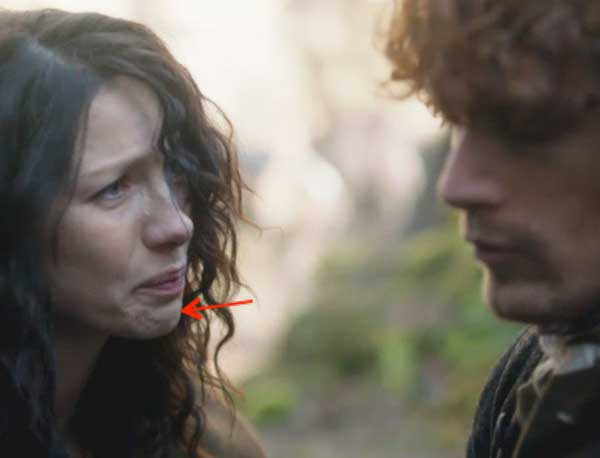
Finally, no chin discussion would be complete without considering chin shape: is a chin smooth, dimpled, creased, clefted or using urban-speak, the awful “butt chin” (who dreamed that one up)? All these chin shapes are considered normal variants but, interestingly, the cleft chin is most common in people of European descent.
Science teachers may use the cleft chin as an example of a dominant genetic trait. But like the earlobe (Anatomy Lesson #24), the broad range of chin types should not be observed if simple dominant-recessive inheritance is at work. Other possible explanations for chin shapes include variable gene penetrance but this is beyond our present discussion.
Humans have long favored chin dimples as a mark of beauty. In Persian literature, the chin dimple is a “well” into which a poor lover falls and becomes trapped! Because a forest of growth covers the chins of most Starz Highlanders (the lads, no the lassies!), assessing their chin dimples is a challenge.
Consider dear Dougal whose chin and mandible are thickly furred. In honor of my good friend Jo Kc and the myriad of other Dougal fans, this image is for us! Here, big bad bro Colum abuses Dougal with names like “half-wit” and “numbskull” (Starz episode 110, By the Pricking of My Thumbs). Please employ your virtual imagination to identify as many chin and mandibular features as possible. Enjoy!
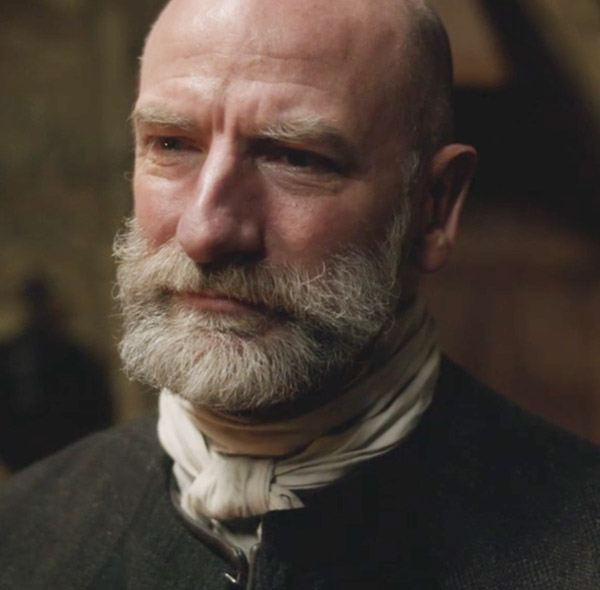
Clean-shaven Highlanders are more rare than a wild haggis but here is that cutie, Willie; his is an excellent example of a smooth chin (Starz episode 114, The Search). Nice eyes, laddie!
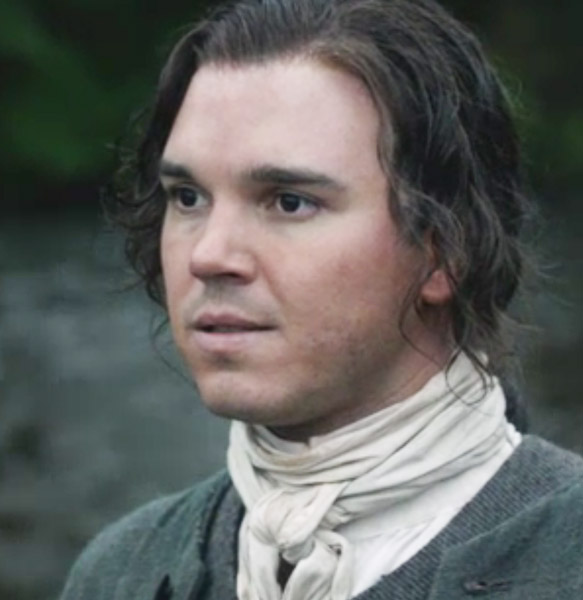
Do ye like Claire’s wee but thoroughly charming chin dimple? Her chin enjoys one degree of separation from the smooth type. Here, she implores her husband: “Come back to me James Frasier” (Starz, episode 110, By the Pricking of My Thumbs). Oh, no! That clever, cunning Colum is sending her darling Jamie away!
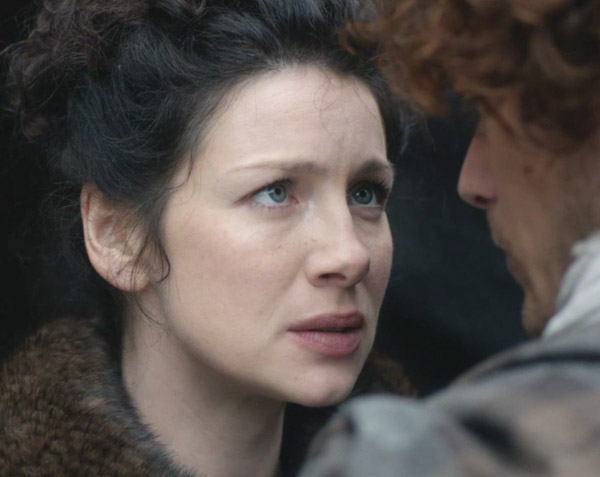
Moving two degrees of freedom from a smooth chin, Jamie’s awesome chin crease sends many a heart into cardiac arrest (Starz episode 113, The Watch)! Ye can see it well despite the bit o’ scruff that typically adorns his manly mentus. Herself writes about this in Outlander book:
“Good.” He loosened his grip and turned me to face him. At close range, I could see the bristle of auburn stubble on cheek and chin. I brushed my fingers across it; it was like the plush on an old- fashioned sofa, stiff and soft at the same time.”
Ummm, gulp!
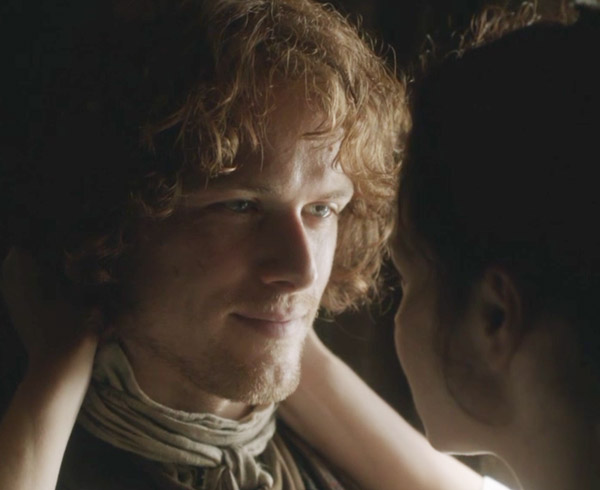
Oh, what? You canna see Jamie’s chin crease clearly enough? Okay, here is the only image of a clean-shaven Jamie I can find in the episodes (Starz opening credits). Do ye ken the crease now? Of course ye do. Won’t be sleeping tonight? Oooh, so sorry! Join the bazillions of fans who L-O-V-E Jamie’s chin!
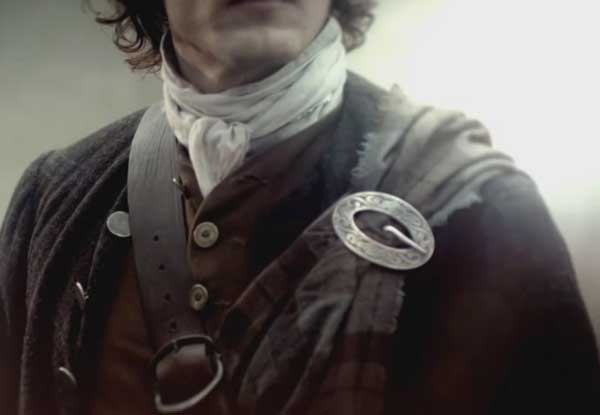
Okay folks let’s finish this lesson with a short pop quiz using matching questions. Here are six numbered structures followed by six lettered photos with arrows indicating the body part. Match the named structure with the body part. Answers appear at the end. Ready. Set. GO!
STRUCTURE:
- Mentolabial sulcus
- Angle of mandible
- Body of mandible
- Mentus
- Mentalis muscle
- Masseter muscle
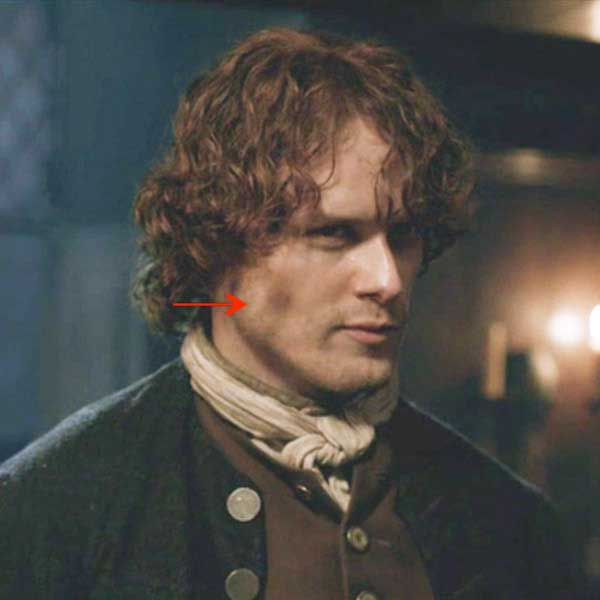
A
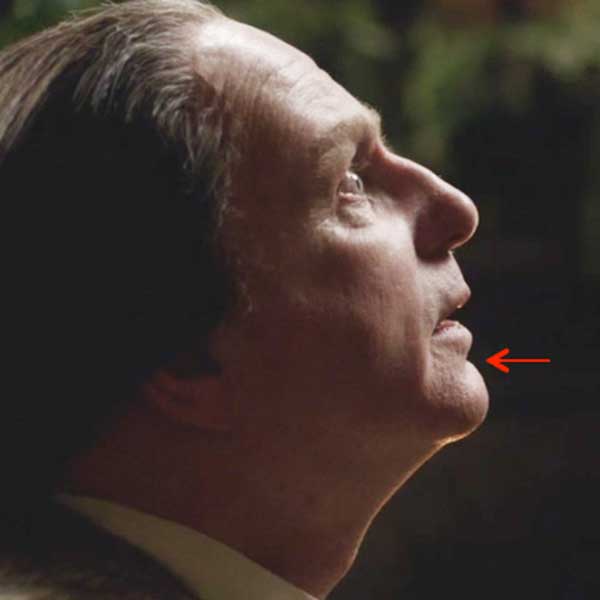
B
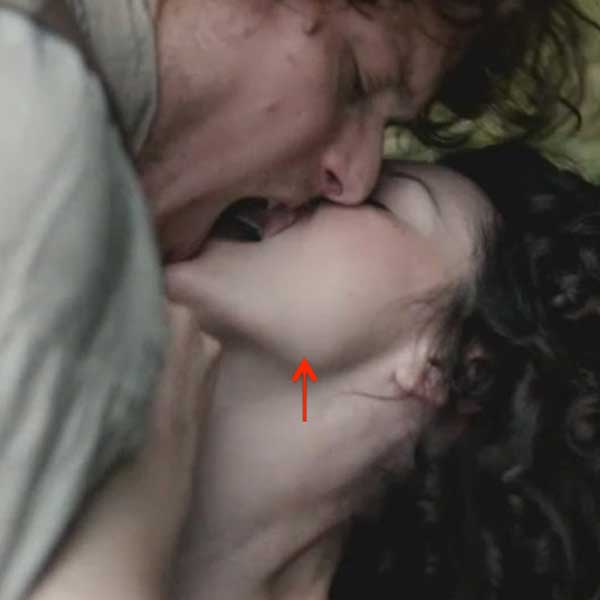
C
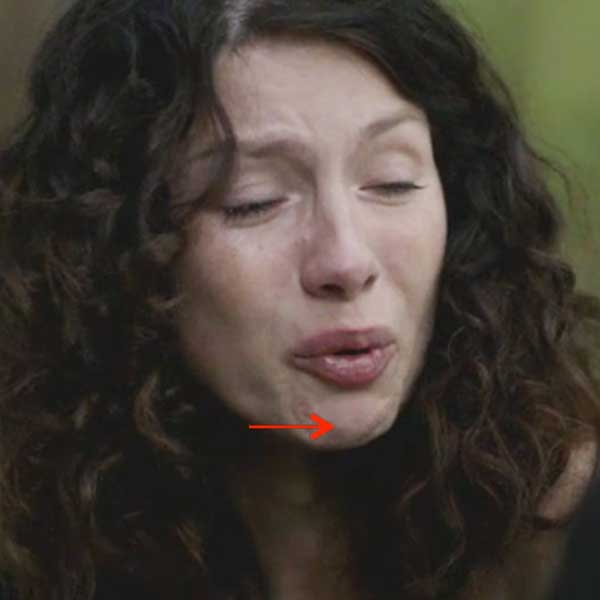
D
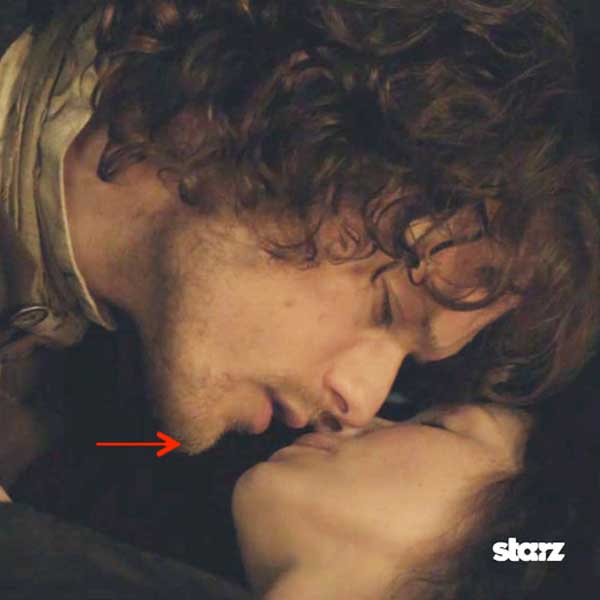
E
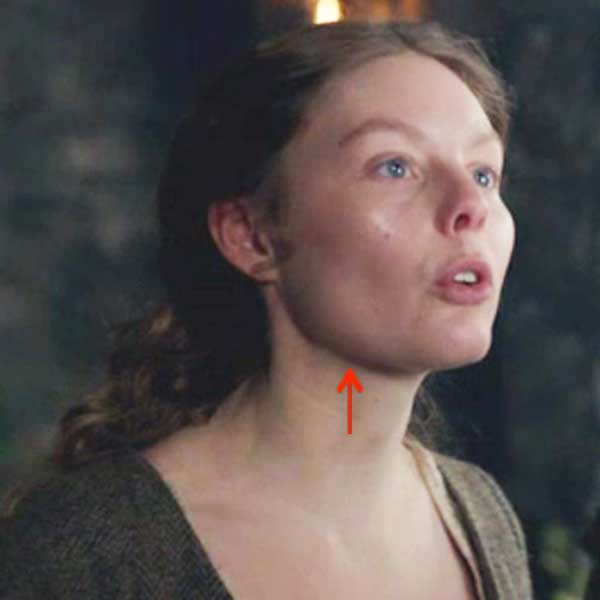
F
ANSWERS:
1 = B (Starz episode 110, By the Pricking of my Thumbs)
2 = C (Starz episode 108, Both Sides Now)
3 = F (Starz episode 110, By the Pricking of my Thumbs)
4 = E (Starz episode 111, The Devil’s Mark)
5 = D (Starz episode 111, The Devil’s Mark)
6 = A (Starz episode 109, The Reckoning)
Hope you did well on the matching quiz. Let’s close this anatomy lesson with a big old chinny chin treat!
Ode to Jamie’s Chin
Jamie Fraser has a chin, a manly chin has he.
His tender fuzz will give you a buzz
And maybe two or three!
Dream of petting Jamie’s chin and leave a kiss or two.
It’ll grieve you much, but do not touch
Lest his wife come into view!
Claire Fraser is a lucky lass but a jealous wench is she.
Dinna touch his chin or she’ll slap your skin
into eternity!
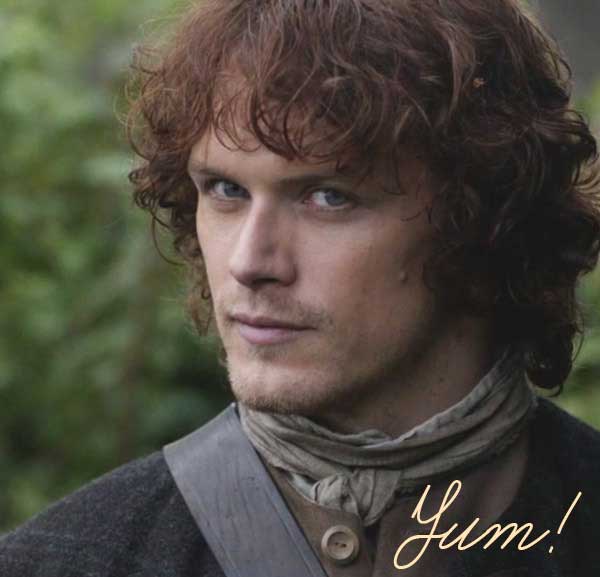
(Starz episode 112, Lallybroch)
A Deeply Grateful,
Outlander Anatomist
Photo creds: Starz, Netter’s Atlas of Human Anatomy, 4th ed., Clinically Oriented Anatomy, 5th ed., www.en.wikipedia.org (elephant)
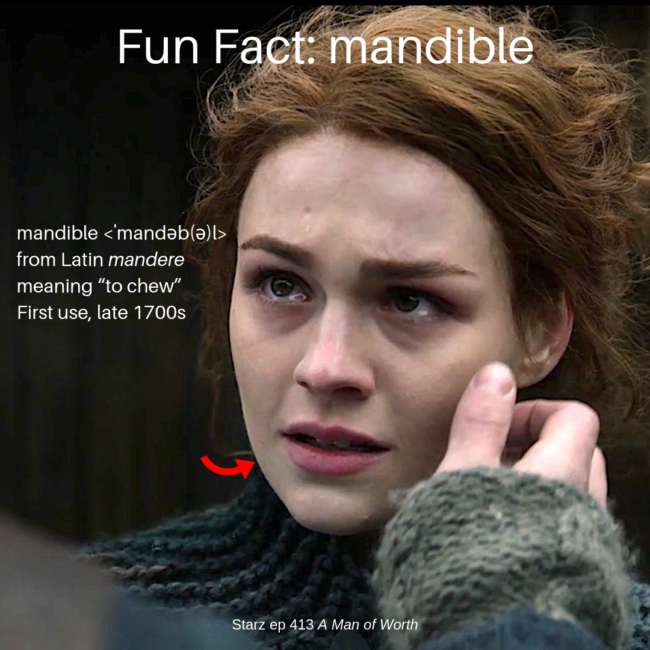 Anatomy Def: The lower jaw or jawbone
Anatomy Def: The lower jaw or jawbone
